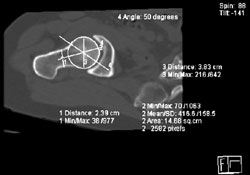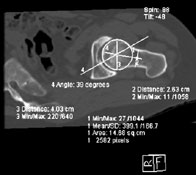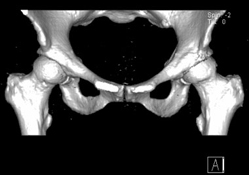Plain radiographs not as accurate as CT scans for femoroacetabular impingement
Researchers found CT scans produce optimal alpha angle measurements of FAI.
LAS VEGAS — Frog lateral plain radiographs, which are commonly used to determine hip alpha angles relative to cam-type femoroacetabular impingement, are not as accurate as CT scans for this purpose, British researchers found in a recent study.
“The alpha angle on the frog lateral radiograph is reliable, but it is not accurate relative to CT scanning,” Fares S. Haddad, FRCS, said.
He presented results at the American Academy of Orthopaedic Surgeons annual meeting here, noting this research did not identify which factors caused the inaccuracy.
|
|
Supine imaging
The frog lateral plain radiograph view of the hip involves an X-ray beam aimed at the center of the femoral head and neck with the patient lying supine on the table. It is done with the pelvis parallel to the table, the ipsilateral knee flexed and that foot placed on the contralateral knee. Larger alpha angles are suggestive of cam impingement.
Investigators evaluated 32 of Haddad’s patients with cam-type femoral acetabular impingement (FAI) confirmed arthroscopically, who were all treated with labral debridement or repair and osteoplasty. They excluded patients with frank dysplasia, acetabular retroversion or severe osteoarthritis. Patients included in the study averaged 32 years-old.
Frog lateral plain radiographs were performed to determine their alpha angle. The patient’s hips were also scanned when they were supine using a helical CT technique. Three-D reconstructions of the hips were used to take their gold standard, alpha angle measurements, Haddad said.
|
|
Images: Haddad FS |
Radiographs vs. CTs
To assess inter-observer variability, two researchers looked at 10 radiographs and to assess variability of intraobserver data, each looked at two readings 4 weeks apart. The results were compared.
Researchers then determined co-efficients for these factors on CT scans and radiographs. Agreement between the imaging methods was rated as slight, less than 0.4; moderate, 0.4 to 0.7; or good, greater than 0.7.
Haddad and colleagues used a similar process and Kappa coefficient to correlate head sphericity measurements on the radiographs.
Head sphericity
“We found a high interobserver reliability for the alpha angle on frog lateral view and a high intra-observer reliability for this variable,” he said. “However, we found a moderate reliability for assessing sphericity of the femoral head.
“When we started to compare the alpha angle on the CTs, which is our gold standard, with frog lateral radiographs we found a significant difference in the variables with one-third of cases within 5°, one-third of cases between 5° and 10°, and one-third with a greater than 10° difference,” Haddad said. “The plain radiographs underestimated the alpha angle in over half the cases.” The correlation was poor, with a 0.2 coefficient, Haddad explained. Why this was the case was unclear, but was probably due to a combination of factors such as patient placement, radiographic projection, differences between radiologists and patient build, he told Orthopedics Today.
The ability to radiologically follow patients with FAI helps physicians track the evolution of the impingement, as well as determine if the extent of an open or arthroscopic ostectomy was sufficient.
Haddad said plain radiographs confirm a cam lesion’s existence, but that he does not believe, based on his data, that you can reliably rule out the cam lesion, particularly on the follow-up plain radiographs.
 |
 |
|
CT scans provided researchers with a moderately better ability to estimate femoral head sphericity vs. frog lateral X-rays. |
|
For more information:
- Fares S. Haddad, FRCS, can be reached at Princess Grace Hospital, 42-52 Nottingham Place, London W1U 5NY, England; 44-0207-935-6083; e-mail: ortho@fareshaddad.net. He has no direct financial interest in any products or companies mentioned in this article.
Reference:
- Konan S, Rayan F, Haddad FS. Is frog lateral plain radiograph a reliable predictor of alpha angle in FAI? Paper #520. Presented at the American Academy of Orthopaedic Surgeons 76th Annual Meeting. Feb. 25-28, 2009. Las Vegas.



